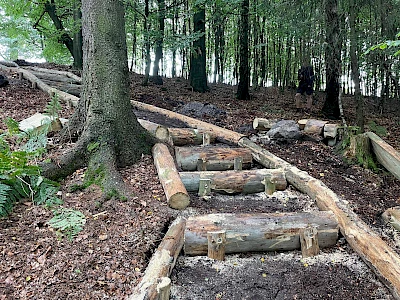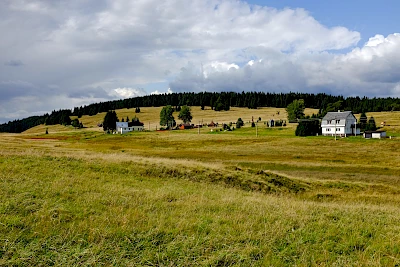Derweil in Tschechien... 35/25
12.09.2025
National parks prepare new hiking trail across the border

It is a small sensation. A new cross-border hiking trail will be opened between the Saxon Switzerland and Bohemian Switzerland national parks next spring. It will be the first new hiking trail to directly connect the two national parks since the Bohemian Switzerland National Park was established in 2000. However, the newly marked hiking trail is not a completely new trail. On the German side, it consists of already marked hiking trails and runs via Reitsteig and Fremdenweg to the Großer Winterberg, from there down the Winterbergstraße and across the Grenzweg and the border to the Czech Republic. There is also an existing trail here, known as the historic Promenade Trail, which runs above the Elbe and Kamnitz valleys (Kamenice).
In the future, the newly marked trail will also officially cross the Promenade Trail, but this is not yet possible for safety reasons. The Bohemian Switzerland National Park is therefore building a new spur trail up to Dlouhý roh (Long Horn) at a cost of 22,000 euros. From there, the trail leads along existing paths down into the Suchá Bělá valley and on to the road from Hřensko to Mezní Louka (Rainwiese), before turning off onto the Mlýnská cesta (Mill Trail) towards Mezná (Stimmersdorf) after a while.
The newly marked trail runs completely outside the quiet zone in the Czech Republic, which is why walking on it would already be permitted. You are not allowed to leave marked paths within the quiet zone. However, there are hardly any marked paths in the quiet zone on the Czech side. In Saxon Switzerland, on the other hand, hikers can use a dense network of marked hiking trails even in the quiet zone.
Reminders of vanished villages

For the third year in a row, the Czech Republic is commemorating vanished villages on September 20. This year, the central ceremony will take place in Jelení (Hirschenstand) in the Ore Mountains.
Disappeared villages are primarily those that were depopulated by the expulsion of the German population after 1945 and were not repopulated afterwards. Many villages were located in the mountains with harsh climatic conditions that new settlers were often unable to cope with. At the same time, many workers were needed in the North Bohemian industry, which meant that the former German villages in the mountains were abandoned or not resettled at all.
Czechoslovakia also created a heavily guarded border directly in the border region, not only with West Germany, but also with the friendly GDR. As a result, many villages were razed to the ground. Another reason for the destruction of villages was the creation of restricted military areas, such as in the Doupovské Mountains, as well as the ongoing open-cast lignite mining and the creation of dams and reservoirs. A total of 2,400 places are said to have disappeared.

A young family has taken over one of the few remaining houses in Jelení (Hirschenstand) in the Ore Mountains and runs a cozy guesthouse with an alpaca farm. This family is also portrayed in the book "Mitten am Rande", which was published by the Elbe/Labe Euroregion 2021 together with the Czech association Antikomplex. The book is unfortunately out of print, but you can read the interview with Alice Janstová (and many others) online. You will learn a lot about the place and its surroundings and will be drawn there all the more.
To the interview with Alice Janstová
Next milestone for high-speed rail line
The Czech railroad administration has published the documentation for the first Czech section of the planned Prague-Dresden high-speed rail line. This involves the first section from Prague to the vicinity of Litoměřice. This section is generally considered to be the least problematic and, according to the plans, is to be built and completed first. It will be followed by the section through the Central Bohemian Uplands, which will be the last to be completed. The third Czech section is the one via Ústí nad Labem and through the Ore Mountains tunnel to the German-Czech border.
The environmental impact assessment process can begin with the documentation. This examines the impact of the construction project on the environment. Authorities, local self-governments, various organizations and also the affected public can participate in the process and raise objections that the railroad administration must refute or change its plans. Only once the environmental impact assessment has been successfully completed do the planning approval and building permit processes begin.
Although the railroad administration is making good progress, there are also risks in this first section. This is because one municipality (Hrobce) is still taking legal action against the route that was approved by the Ústí nad Labem district last year. So far, the legal action has been unsuccessful. The municipality now wants to appeal to the Constitutional Court.
North Bohemian rents on the rise
North Bohemia, and the Ústí district in particular, is one of the poorest regions in the Czech Republic. As a result, rents for apartments have tended to be moderate in the past. However, this has no longer been the case for the past three years. In cities such as Ústí nad Labem, Děčín, Litoměřice and Louny in particular, rents have risen by an average of 30 to 40 percent in the last three years. The daily newspaper Mladá fronta Dnes reports on cases in which rents have risen by half in some cases. For example, a young couple in Ústí used to pay 9,000 crowns (360 euros) for a 2+1 apartment (2 rooms plus kitchen and bathroom). Now they have to pay 12,000 crowns (480 euros), which for the couple means a full net salary for one of them.
In addition to inflation, the report also blames the influx of students in Ústí, in Děčín the proximity to Saxony (interesting for commuters) and in Louny and Litoměřice the proximity to Prague (also for commuters). Experts expect a further increase in the coming years, albeit at a slower pace.
In the Czech Republic, home ownership is much more widespread than in Germany. However, higher mortgage interest rates and stricter rules, particularly with regard to a higher equity ratio, have made access to home ownership much more difficult, especially for young people. They are mainly the ones who now live in rented accommodation without any prospect of home ownership.
Ten new Saxon-Czech projects approved
The small project fund in the Elbe/Labe Euroregion supports Saxon-Czech projects with up to 20,000 euros. The decision-making committee met today in the City-Wache in Dresden. It received 11 project applications, slightly fewer than hoped for. Funding amounting to €69,017.60 was approved for 10 applications. One application was rejected.
In contrast to the last meeting in June, this time there was only one sports project. Instead, the areas of culture and education, as well as social issues, were more strongly represented.
Five of the approved applications with a funding volume of €33,206.40 came from German applicants, and five applications with a funding volume of €35,811.20 also came from Czech applicants.
All information on the individual projects (including the rejected projects) can be found on the website of the Elbe/Labe Euroregion.
If you would like to receive our weekly review regularly in your e-mail inbox, please register for our newsletter.
